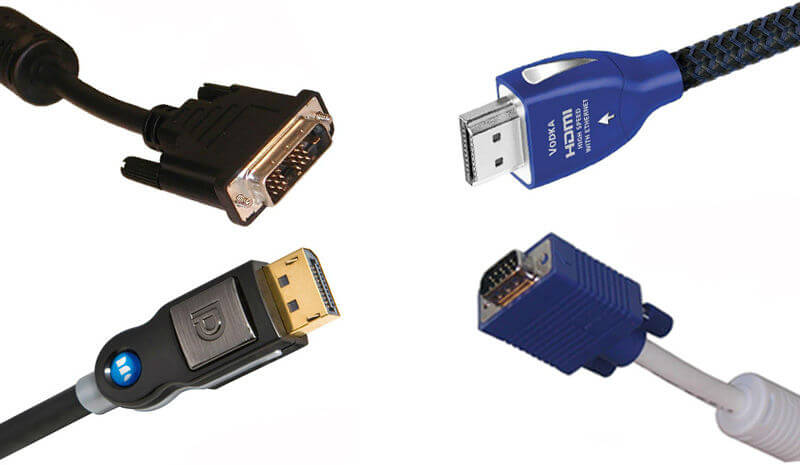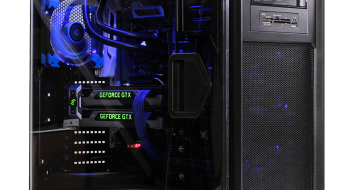When connecting a computer to a monitor or TV there are several connections to choose from. Each connection has its pros and cons, so how do you choose? It’s important to note that all of these connections, except for VGA, are digital so while maximum resolutions will vary, the quality does not. This means that 1920×1080 at 60Hz should look the same over HDMI, DVI and DisplayPort, assuming settings are the same. In the real world this doesn’t always happen – see the last paragraph about color spaces and screen tearing.
When you’re shopping for a new graphics card, gaming pc, or display, you’ll need to consider how you’re going to connect the display to the computer. HDMI and DisplayPort are different connections that both support 4K resolutions. HDMI is the best choice if you are just connecting a gaming console, blu-ray player or streaming device to your TV. DVI is a good choice if you’re looking to get the most out your high frame rate on a 1080p monitor.
With the latest graphics cards, gaming at 4K resolution and a 120Hz refresh rate is possible. All the newest GPUs, like the AMD RX 6000 Series and NVIDIA’s GeForce RTX 30 Series support DisplayPort 1.4. For now, we recommend gaming at 1440p or 1080p at high refresh rates like 120 or 144 Hz.
HDMI
HDMI, or High Definition Media Interface, is the standard for HDTVs and is on most computer monitors. It’s easy to use because it carries audio too. If you’re going to plug your PC into a TV HDMI is the way to go. HDMI is fine for most resolutions. If your display or TV has HDMI 1.4, you’ll be limited to 3,820×2160, 4K, at 30 Hz. However if you’ve got a video card and 4K display with HDMI 2.0, you’ll be able to get 4K at 60 Hz. HDMI was designed to be backwards compatible with DVI, so there is no loss of video quality when using an HDMI-to-DVI adapter or cable.
It’s important to note that while you shouldn’t go spending big bucks on HDMI cables since most are the same, different cables have different speed ratings. You’ll need a high speed (category 2) cable for resolutions above 1080i. Fortunately for most people, high speed cables created for HDMI 1.4 will meet the specifications of HDMI 2.0. Some cables have support for HDMI with Ethernet, but very few devices actually make use of this feature. To recap, there are four kinds of HDMI cables: high speed with Ethernet, high speed without Ethernet, standard speed with Ethernet and standard speed without Ethernet. An expensive high speed cable will not improve the picture over a $2.50 high speed cable.
DisplayPort
DisplayPort is the best choice for connecting a computer to a monitor. The older DisplayPort 1.2 is capable of 3840×2160, 4K, at 60 Hz; or 1080p resolution at 144Hz – DisplayPort 1.3, announced in September 2014, is capable of 8K at 60Hz or 4k at 120Hz! The GeForce GTX 980 Ti only has DisplayPort 1.2, limiting it to 4K at 60Hz.
The newest graphics cards from NVIDIA and AMD feature DisplayPort 1.4, which means that they will be able to do 4K at 120Hz, or even 8K at 60hz! Finding a compatible monitor is another story. If you want to play modern games at a 4K resolution and at 120Hz, you will need an RTX 3080.
DisplayPort can run multiple monitors from a single cable: you can use hubs or displays that support daisy chaining. With DisplayPort 1.3 you can run two displays at 4k at 60Hz from a single DisplayPort cable! This new standard even allows for 5K displays – even though there are few on the market and you’ll need a beastly custom gaming PC to play games at this resolution. Dual-mode DisplayPort (also known as DisplayPort++) can also be adapted to DVI and HDMI with a simple passive adapter. DisplayPort is the clear choice for high FPS or 4K gameplay.
DisplayPort can carry audio too, although it’s up to the manufacturer to support and implement audio over DisplayPort, so some devices from some brands will have it, while others may not. In some cases the video driver would be responsible for the sound signal, rather than the audio driver. You might need to update your drivers to make it work. Some users of Apple MacBooks have found that they were unable to output sound via DisplayPort unless they were using a DisplayPort to HDMI adapter.
DVI
The DVI, or Digital Visual Interface, connection is starting to die out, although it is still on every graphics card. The video signal is basically the same as HDMI, just without the audio. However DVI in newer graphic cards will transmit audio when connected with a DVI to HDMI cable or adapter. Single-link cables and hardware support up to only 1,920×1,200 resolution, but dual-link DVI supports 2560×1600. DVI is capable of 144hz refresh rates, so it’s a good choice if you have a 1080p 144hz monitor. This is especially true for gamers who have an FPS that is higher than 60. If you want 4K, though, you’ll need to go with DisplayPort or HDMI. Just like the other cables can be adapted to DVI, DVI can be adapted to VGA with a passive adapter.
VGA
VGA, or Visual Graphics Array, is the oldest display connection standard of the bunch. It’s an analog, video-only connection that’s rarely seen on TVs, though you’ll find it in older projectors and displays. We don’t recommend using VGA, but sometimes it’s the only option. VGA connections are handy when dealing with legacy systems or equipment. Most older laptops only have a VGA output but newer ones tend to have DisplayPort or HDMI connections.
Lastly, let’s make a note that some users we’ve talked to have had screen tearing issues when using HDMI cables. Screen tearing usually happens when your frame rate doesn’t match up to your screen’s refresh rate. We covered this topic in our blog post on Frame Rate (FPS) vs Refresh Rate (Hz). These users only experienced this issue when using HDMI cables, and not others like DVI or DisplayPort. This is interesting because the color spaces for HDMI are different from that for DisplayPort, DVI and VGA – HDMI can use YCbCr while the others use RGB. Some TV’s will not support RGB, so that’s a possible reason why most TVs have HDMI and not DisplayPort. Our recommendation is to use DisplayPort for connecting to a monitor, and HDMI when connecting to a TV.







Very good article. Thx
No, it’s not.
They don’t mention important things like the difference between DVI-I, DVI-D (and DVI-A), or the lack of HDCP on most DVI ports.
Sehr guter Artikel. Wenn es um Datenübertragung und Brillianz geht, gibt es derzeit nichts besseres als das HMDI Kabel. Das bestätigen auch die Tests von.
DVI-(D) can support MORE video-bandwidth than HDMI can.
Also DisplayPort is even slightly better than both.
AND, DVI and DisplayPort are not “encumbered” with non-free license restrictions, -like HDMI is.
and that’s why Consumer’s like you and me, pay more for HDMI, even though it’s hidden.
what’s faster?
Hi James. Although you won’t be transferring files with either cable, DisplayPort is technically “faster” because it has a bandwidth of 21.6 Gbit/s compared to HDMI’s 10.2 Gbit/s.
what’s the faster between hdmi and display port? thanks.
DisplayPort is faster. DisPlayport 1.3 and 1.4 have a bandwidth of 21.6 Gbit/s compared to HDMI 2.0’s 18 Gbit/s.
I’m building a new i7 6700K PC and the Motherboard doesn’t have a Display Port. That means I have to wait for the graphics card.
Could I use a vga cable for this purpose?
Bruh! Since when does a motherboard have a PC board? Use your brains dude! Your graphic cards have all the ports! Are you sure you’re ready to build your own PC with this little knowledge?
Already did it.
Most motherboards do have on-board video (except for motherboards built for use with Intel Core i7 Extreme or Xeon processors). If your motherboard has a VGA, HDMI or DVI port you can use that. However don’t expect great graphics performance. What motherboard are you using?
MSI Z170A Gaming M5
Looks like that motherboard has all the video ports: DVI, VGA, HDMI and DisplayPort. Should be fine. If you’re planning on gaming you’ll want to wait for the graphics card. Gaming without one will give you low resolution, low frame rates, or probably both.
Thanks for your suggestion :)
hi there
my english is not good so let me ask you 2 questions => (i play my games at 1080p i have xl2411z)
1/ who give better quality and colors HDMI or dvi-dual link ?
(some people say that there is no difference in colors betwen them but i try both and i can feel the difference im right or im just imagining ?)
2/ i have hdmi and dvi-d dual link so do i need to buy a DisplayPort to get hdmi features (quality) + dvi-d features (fps 144hz) ?
Hello!
1)The color spaces for HDMI are different than that for DisplayPort, DVI and VGA – HDMI can use YCbCr while the others use RGB. DVI is locked into using RGB, but HDMI can use either RGB or YCbCr colors. You should be able to adjust the color space, as well as other color settings and find one that you like.
2)DisplayPort, HDMI and DVI are all digital, so they should have the same quality signal. They do have their pros and cons: DVI does high refresh rates, HDMI does high resolutions, and DisplayPort does both.
If you’re gaming at 1080p, then there’s no real point to switching from DVI to DisplayPort. However if you are using HDMI, switching to DVI or DisplayPort would allow you to take advantage of faster refresh rates.
If you’re planning on gaming at higher resolutions in the future, consider DisplayPort.
Hope this helps!
Thank you for the great article!
Please, I just changed two GTX 580 in SLI for one GTX 1080. Before I used 3 DVI dual link cables to connect to my 3 surround monitors and used to get 120 Hz.
Now I’ve connected my single card with the 3 monitors using the options available, ie, only one DVI… I ended up connecting one with DVI, one DisplayPort and one HDMI (only had one spare cable of each). The problem is, now I can’t enable 120 Hz! I’m stuck with 60 Hz…
Please could you help me? Which cable could be the culprit? Which cables should I use to work the full 120 Hz? Thank you!!
Hi Rogerio. HDMI can’t do 120hz. GTX 1080s have three DisplayPorts so I suggest you use those. Do all three of your monitors support it?
Really?? Even if it is HDMI 2.0b, which is how it’s written in the specification… Humm, maybe the monitor doesn’t support it. And yeah, all three have DP inputs, they are BENQ XL2420T… Will buy 3 identical DisplayPort cables and give it a try! Thank you!
HDMI 2.0 technically could do 120hz at 1080p, but very often it’s not implemented that way in monitors. HDMI is ultimately built for TVs but because of its prevalence it is also commonly found in monitors. DVI dual-link and DisplayPort are the recommended connections for high frequency outputs. If you’re going to be buying cables anyway, I suggest DisplayPort.
EDIT: I couldn’t find info for your specific monitor but the XL2420G only has HDMI 1.4 which would definitely limit you refresh rate.
I’m going to buy a monitor and a gpu, I’d like to know if they would get compatible with each other, written on the gpu: Output DisplayPort x 3 (Version 1.4) and written on the monitor: Input : HDMI, DisplayPort 1.2 hence is it ok to connect different versions of DisplayPort together?
Hi there, I just happened upon your post and I learned a bit from it but perhaps you could help me with this setup I’m trying to figure out, I have had it ‘set up’ for awhile now just not sure I am getting the full benefit of my equipment.
Marantz NR-1607
LG 55UH7700
Xbox One S-With the dual hdmi
HTPC-GTX 1070
I am only using 2-channel stereo so this eliminates some issues like the lossless audio formats that can play over the nvidia hd, I also have the optical connector being used at the moment and I suspect that is a bit redundant but atm its going from the TV to the AVR.
Most of my TV watching is done over the HTPC, with 4K movies being played on the Xbox One but was also wondering if I would be better to watch 4K Netflix using the Xbox or the HTPC with the 1070.
One last question, is it better to have the TV doing scaling or the 1070.
Thanks in advance and for the free info.
Ok, I know I’m gonna sound stupid here but here goes anyway. I hate HDMI. Been using it for years . I thought I didn’t have an option. It was a step up from DVI. Why do I hate HDMI viciously? Sound. I have none. I should say the tiny speakers on my Vizio allow for some. But for the life of me, I’ve not been able to figure out how to get the sound from the computer , using HDMI and then get it to my 5.1 speaker set up. Shaking my head. Your article , at least the parts I could understand, gave this noob hope. I just hope I don’t have to blow up the computer, buy a new monitor just so I can use my 5.1s. I would be very grateful is someone could show or tell something. Somebody help a noob out?
right click on the audio icon in the taskbar. click on Playback Devices, and then just disable the display output by right clicking it. The system will then try to switch to other devices that are connected
“DVI can be adapted to VGA with a passive adapter” is not universally true, you need a DVI-I port for that. If you just have a DVI-D (pure digital without analog) then it won’t work.